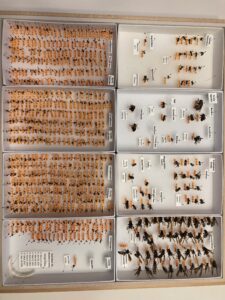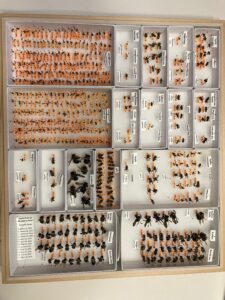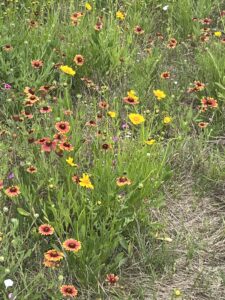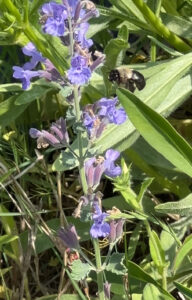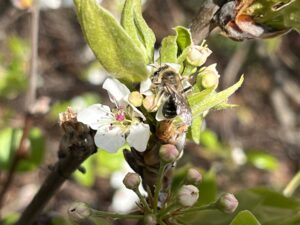Final report for OS22-150
Project Information
The chief pollinator of U.S agriculture, the honeybee, is under serious threat. Honeybees face significant colony losses from Colony Collapse Disorder and other factors. This has significantly increased the cost of renting honeybee hives, which has significantly added to the production costs for farmers and has even endangered the U.S. food supply from a lack of possible pollinators in the future.
The best alternative to honeybees is the wild bees (native bees) already present in the local environment [1, 10-11]. With nearly 3500 species in North America alone, the diversity of different forms, pollen-strategies, and behaviors of native bees provide a wide range of use for agricultural operations.
Thus, the answer to creating a secure and sustainable pollination system in U.S. agriculture is native bees. Past research suggests two main methods to boost native bees in agricultural areas: (a) by providing nesting habitats and (b) by providing additional floral resources (particularly during periods of low food availability). Food resources were targeted by this study, since in the Southeastern U.S. region, the most useful native bees are ground nesting bees that could also nest in the wildflower plots [5]. The targeted ground nesting native bees include mining bees (Genus Andrena), bumble bees (Genus Bombus), and sweat bees (Genera: Augochlorella, Halictus, Lasioglossum).
The main purpose of the proposed study is to assess the benefits of floral enhancements (wildflower plots) to boosting native bee and pollinators in blueberry farms. Studies have shown floral enhancements on the edges of orchards and farms have had a significant effect in recruiting or bringing in more native bees. Now, scientists need to explore what is really going on in the wildflower patches during each major period of the growing season. Specifically, we need to know what is going on during the (1) pre-bloom period, (2) bloom period of the target crop (blueberries), and the (3) post-bloom period/summer dearth period (period of few floral resources).
Past research on native bees in Georgia have focused on the northern apple producing areas of Georgia. This will be one of the first studies with native bees in central Georgia. Thus, the study’s results will also allow us to compare and contrast native bees’ seasonal diversity and abundance in Northern Georgia (clay soils) verses Central Georgia (sandy soils).
Each region of the U.S. varies in farming conditions, bloom times, and variety of native bee species that are available for pollination activities [12]. Regional studies such as the proposed study are essential in gathering accurate information on which wildflower species have the best native bee recruitment characteristics.
In the current study, we studied wildflower effectiveness in recruiting bees and surveyed native bee diversity and abundance in the poorly studied Coastal Plain of Central Georgia. Twenty-two different wildflower species were seeded in wildflower enrichment patches next to experimental plots of blueberry bushes. Wildflowers were observed for bee visitation. The wildflowers that recruited the most bees were Indian Blanket (Gaillardia aristata), Lanceleaf Tickseed (Coreopsis lanceolata), Red Clover (Trifolium pratense), and Cosmos Sensation (Cosmos bipinnatus). Bees were surveyed in 2022 and 2023 to determine the impact of the wildflower plots on bee abundance and diversity. In 2023, the assembly of bees on the farm significantly changed.
During the first year of the study (2022 control year), 590 bees were collected. Small sweat bees dominated the collection, making up 89% of the collection. During the second year of the study (2023 experimental year), 510 bees were collected. Small sweat bee abundance in the collection dropped to 58%. The wildflower plots significantly altered the bee diversity and abundance of major bee groups. Large size bees (bumble bee and carpenter bee) increased 10-fold from 4 to 47 bees collected, and medium- size bee (blueberry bees and mining bees) increased 10-fold from 24 to 76 bees collected in the bee sampling.
Plots with wildflowers attracted more than double the bees. Sampling of plots with wildflowers yielded 359 bees verses only 151 bees sampled in control (no wildflower added) plots.
The bee numbers did not increase from control year (2022) to experimental year (2023), but rather the makeup of the bee community changed. However, the small, rather insignificant, sweat bees were replaced by large and very efficient bumble bees, blue berry bees, and mining bees. Scientists have long questioned the impact of the “gnat-size” sweat bees in pollination effectiveness, while the large bumble bees, blue berry bees, and mining bees have been documented to be effective pollinators and to carry large pollen loads flower to flower.
The project main objective was to measure the effect of adding wildflower plots in agricultural areas on native bee populations, we performed an on-farm field experiment. The experimental location for the on-farm research project was the Pinefield Eco Farm in Hephzibah, Georgia. On the farm, we created six plots of blueberry bushes (3 control and 3 experimental). Figure 1. is a diagram of the plot design at the farm.
Figure 1. A diagram of the plot design at the farm
Each experimental plot consisted of 4 rows of blueberry bushes and 1 row of wildflower plants. The wildflower row was roughly 200 ft2 (50 ft x 4 ft) and sat in the center, between the two rows of blueberry bushes surrounding it on either side. The control plots each had 4 rows of blueberry bushes. The control plots are located on the opposite side of the farm, in regards to the experimental plots.
Objective 1: Measure native bee abundance in experiment blueberry plots with wildflowers vs. control blueberry plots during each of the 3 major periods of the growing season.
To gather the data needed to test this objective, we used a range of sampling methods shown to accurately sample native bee abundance and diversity in North Georgia Apple Orchards, based on a modified Bee Inventory Plot Design [5].
Year 1 (2022) was the control year. Six blueberry plots (3 control and 3 experimental) were set-up on the farm. We performed eight monthly samples (March-September) in each plot. Year 2 (2023) was the experimental year. We performed twelve samples, during the bee season: Pre-Bloom Sampling (March), Blueberry Bloom (April), and Post-Bloom/Summer Floral Dearth (May - September).
All bee samples collected were stored in 95% ethanol and taken back to Georgia Gwinnett College. They were washed, sorted, pinned, and then identified to genus. Professor Schlueter led the team of GGC undergraduates on sorting the samples and identifying the bees.
Objective 2: Determine which target bee species is present in each of the major periods of the growing season.
There are three major periods of concern: Pre-bloom, Bloom, and Post-Bloom/Summer Dearth (Poor food availability in farms).
During each day of sampling, researchers staked out and observed each flowering wildflower species. Each bee that landed on a targeted wildflower was photographed and/or collected. The majority of the bees were photographed to reduce damage to the wildflowers. The collected bees were be taken back to GGC for identification.
Objective 3: Assess native bee pollination behaviors on wildflowers.
During each day of sampling, researchers staked out and observed each flowering wildflower species. Video cameras mounted on tripods were also used to measure native bee behaviors at wildflowers and at the blueberry flowers. Video cameras allow bees to act normally, without the presence of humans, and frees up students to perform other sampling. However, the high heat limited the video cameras use. Battery life was significantly reduced. Due to video camera limitations ( small field of view and limited battery life), human observation yielded the best data and results.
The three goals of this objective are to determine: (1) which bee species is visiting which flower species, (2) the length of time individual bees spend on each flower, and (3) the types of interactions that occurs (e.g. buzz pollination, full body submersion into flower, etc.).
Objective 4: Assess the effect native bee pollination has on boosting blueberry crop quality and overall yield.
Later in the season, several bushes in each of the plots (Control and Experimental) were assessed for their overall blueberry yield. We examined two factors: (1) overall fruit quality (based on average size (width) of the berry) and (2) the average amount of berries produced by each bush (numbers and weight).
The data gathered allowed us to make conclusions about which wildflowers have the best characteristics for recruiting native bees to agriculture areas. Conclusions on the benefits on native bee pollination and the use of wildflowers plots can also be made based on their overall impact in boosting crop quality and amount.
Cooperators
- (Researcher)
Research
Objective 1: Sampling of the native bees
During the first year of the study (2022), there were 8 bee sampling events at the blueberry farm. The sampling events were on: March 22, April 22, May 10, May 28, June 10, June 17, July 8, and September 24.
In year 2 (2023), the experimental plot had wildflowers throughout the season. Wildflower plants and seeds were added to the plots during the summer of 2022, and wildflower seed was added in December 2022.
During the second year of the study, there were 12 bee sampling events at the blueberry farm. The sampling events were on: March 8, March 18, March 24, March 31, April 15, April 22, May 26, June 9, June 16, June 23, July 28, and September 23.
Each of the six plots was passively sampled using a total of 6 sets of bowl traps (each set consists of 1 UV blue bowl, 1 UV yellow bowl, and 1 white bowl) and 1 malaise trap. During sample days, active sampling was performed by timed sweep netting of 30 minutes in each plot.
Objective 2: Determine which target bee species is present in each of the major periods of the growing season.
In year 1 (2022) and year 2 (2023), we performed sampling from March to September. Data was sorted to identify the bees present in the orchard at different time frames.
Objective 3: Assess native bee pollination behaviors on wildflowers.
In year 2 (2023), we recorded bee activity at various blueberry flowers and wildflowers during each sampling event (March - September). Both human observation and video cameras were used to record bee presence and behavior at specific wildflowers.
Objective 4: Sample of blueberry fruit in the experimental area (plots 1-3) and the control area (plots 4-6)
During year 1 (2022) of the study, we compared the blueberry fruit produced in the experimental area (plots 1-3) and the control area (plots 4-6). In year 2 (2023), the experimental plot had wildflowers throughout the season. During year 2 (2023) of the study, we compared the blueberry fruit produced in the experimental area (plots 1-3) and the control area (plots 4-6).
Objective 1: Sampling of the native bees
In 2022 (Control Year – wildflowers absent), 590 bees were collected during sampling events. Small sweat bees (Lasioglossum species) (89.5%) dominated the sample (Table 1), (Figure 2).
Table 1 - 2022 Bee Collection Results
In 2023 (Experimental Year – wildflowers were present all season), 510 native bees were collected during sampling events. Small sweat bees declined in abundance to 58% of the sample; while large-size bees (e.g. Bombus and Xylocopa) and medium-size bees (e.g. Andrena and Habropoda) significantly increased in abundance (Tables 2 and 3), (Figure 3).
Table 2 -2023 Bee Collection Results
Table 3 - Differences in Bee Collections 2022 -2023
In 2023 (Experimental Year – wildflowers were present all season), the 3 blueberry plots with added wildflowers patches had more than twice the number of bees than the 3 control plots that did not have wildflower patches. There were 359 bees collected in the experimental plots and 151 bees collected in the control plots (Table 4).
Table 4 - Control verse Experimental Plot Collections in 2023
The wildflower plots significantly altered the bee diversity and abundance of major bee groups. Large size bees (bumble bee and carpenter bee) increased 10-fold from 4 to 47 bees collected, and medium- size bee (blueberry bees and mining bees) increased 10-fold from 24 to 76 bees collected in the bee sampling.
The bee numbers did not increase from control year (2022) to experimental year (2023), but rather the makeup of the bee community changed. However, the small, rather insignificant, sweat bees were replaced by large and very efficient bumble bees, blue berry bees, and mining bees. Scientists have long questioned the impact of the “gnat-size” sweat bees in pollination effectiveness, while the large bumble bees, blue berry bees, and mining bees have been documented to be effective pollinators and to carry large pollen loads flower to flower.
The bee survey will continue for 2 or more years at the blueberry farm. These additional years of investigation will allow us to confirm the results. Several studies indicate that it may take 2 -3 years for wildflower patches to reach their full potential. Preliminary results from year 3 (March - April 2024) have shown a significant increase in flowers in the wildflowers patches. Medium to large size bee abundance also increased. For example, Blueberry Bees (Habropoda laboriosa) had 10 collected in 2022, 39 collected in 2023, and 45 collected during March and April of 2024 (the bloom period).
Conclusion
The addition of the wildflower patches or strips near the blueberry bush plots did more than double the bees numbers compared to blueberry bush plots with no added wildflowers. The addition of the wildflowers patches also significantly altered bee community makeup. Large increases in numbers were seen in medium-large size bees. These larger bees are documented to be effective pollinators.
Special Note – Pollinating Wasps
As noted early, the study took place in the Coastal Plain area of Georgia that contains very sandy soils. This environment was well suited for Scoliid Wasps. Scoliid wasps (Family Scoliidae) are commonly referred to as “hairy flower wasps”. These wasps have been observed to be excellent pollinators and beneficial insects that eat plant pests (e.g. beetle larvae). Scoliid wasps have been observed to occur in large numbers in certain environments. They are often the primary pollinator of certain plants [10].
Scoliid wasps were relatively abundant compared the bees sampled (108 Scoliids versus 508 bees in 2023). There abundance and huge size (females are similar to bumble bees in size) could make them a major pollinator in the Georgia Coastal Plain ecosystem.
In 2022 (Control Year – wildflowers absent) there were 44 Scoliid wasps collected, while in 2023 (Experimental Year – wildflowers were present all season) there were 108 Scoliid wasps collected. The numbers of sampled Scoliid wasp more than doubled after the addition of the wildflower patches.
While bees still receive the majority of the public and researcher’s attention, pollinating wasps can also make a substantial contribution to pollinating crops. The good news: when we add the wildflowers to boost bee abundance, we also boost Scoliid wasp abundance.
Objective 2. Determine which target bee species is present in each of the major periods of the growing season.
Native bees were sampled from March to September in 2022 and 2023. The goal was to determine which groups of bees were present at the major periods of the season.
There are three major periods of concern: Pre-bloom, Bloom, and Post-Bloom/Summer Dearth (Poor food availability in farms). Table 5 shows when major bee groups were present (March -September) during the year.
Table 5 - Bee Genus Occurence over the season
Pre-bloom is the period before the blueberry bushes flower (late February – early March). Bee numbers were sparse during this period. Flowering wildflowers were very limited. Mining Bees (Genus Andrena), Blueberry Bees (Genus Habropoda), Sweat Bees (Genus Lasioglossum), and Mason Bees (Genus Osmia) were represented during this period.
Bloom period is when the blueberry bushes are flowering (late March- April). Bee numbers significantly increased during this period. Wildflowers had begun to flower in fair numbers. All major groups of bees were well represented during this period, except the Genus Megachile, which is known to emerge in the summer. Mining Bees (Genus Andrena), Blueberry Bees (Genus Habropoda), Sweat Bees (Genus Lasioglossum) were the most numerous bee groups present.
Post -Bloom/Summer – This is the post bloom period (Blueberry bushes were not flowering). The wildflower plots were in full swing, with maximum flowering of the wildflowers. All major groups of bees were well represented during this period.
The wildflowers patches were successful in keeping the native bees within the area of the farm. It is hypothesized that a greater number of these bees nested near the farm, rather than dispersed away after the bloom, due to the season long food availability provided by the wildflowers. We will continue to sample the bees for two more years to see if the wildflowers boosted their numbers in the area. Preliminary 2024 results suggest that bee abundance numbers will be higher in 2024.
Objective 3: Observation of bee behaviors at the blueberry flowers and wildflowers
During each sample event, we observed bee activity at both blueberry flowers and wildflowers. Human observation and video cameras were used. However, the majority of the data came from human viewers (e.g. larger field of view, and no video battery issues) (Figures 4-6).
The two most common groups to visit the blueberry flowers and the wildflowers were the Southeastern blueberry bee (Habropoda laboriosa), sweat bees (Genus Lasioglossum), and green sweat bees (Genus Augochlora). Other bee groups were poorly represented.
On the blueberry flowers, several different bee species were observed to interact with the blueberry flowers (late March thru early April). The Southeastern blueberry bee and sweat bees were the most common bees observed. It was observed that the Southeastern blueberry bee spent more than twice the time at each flower compared to the sweat bees.
On the wildflowers, the Southeastern Blueberry bee was most often seen on white and yellow flowers. At the farm, the Southeastern blueberry bee was rarely observed interacting with wildflowers and did not appear in samples after May.
On the wildflowers, the sweat bees were most often seen on yellow flowers. However, they were also observed on white and purple/blue flowers as well. Sweat bees were abundant throughout the farm sampling (March – September).
On the wildflowers, the green sweat bees (Genus Augochlora) were most often seen on yellow flowers. They seemed to “camp” out on the yellow flowers, spending much more time on the wildflowers than other bee groups. This resulted in numerous bee sightings on the yellow wildflowers; however, there was rather low collection numbers in the pan traps.
In the wildflower patcher or strips, the following wildflower species were seeded: Cosmos Sensation (Cosmos bipinnatus), Lance Leaf Tickseed (Coreopsis lanceolata), Plains Coreopsis (Coreopsis tinctoria), Purple Coneflower (Echinacea purpurea), Siberian Wallflower (Erysimum x allionii), Buckwheat (Fagopyrum esculentum), California Poppy Orange (Eschscholzia californica), Indian Blanket Flower (Gaillardia pulchella), Sunflower Lemon Queen (Helianthus annuus), Gayfeather (Liatris spicata), Sweet Alyssum Tall White (Lobularia maritima), Wild Perennial Lupine (Lupinus perennis), Bee Balm (Monarda didyma), Baby Blue Eyes (Nemophila menziesii), Evening Primrose (Oenothera biennis), Red Corn Poppy (Papaver rhoeas), Lacy Phacelia (Phacelia tanacetifolia), Mountain Mint (Pycnanthemum muticum), Yellow Prairie Coneflower (Ratibida columnifera), New England Aster (Symphyotrichum novae-angliae), and Crimson Clover (Trifolium incarnatum).
Each experimental day at the farm (March – September), bee observers watched wildflower patches for up to two hours per day. Wildflower effectiveness was defined as a floral visit by a native bee. Video cameras were also used to measure bee visitations. However, in-person bee/flower counts yielded much higher counts of bee- flower interactions.
The wildflowers that recruited the most bees were Indian Blanket (Gaillardia aristata), Lanceleaf Tickseed (Coreopsis lanceolata), Red Clover (Trifolium pratense), and Cosmos Sensation (Cosmos bipinnatus). Each of these flowers had 50 or more visits (bee- flower interactions). The Indian Blanket (Gaillardia aristate) was visited by the widest range of bees and had the greatest bee visitation rate.
Conclusion
The results suggest that certain species of wildflowers such as Indian Blanket, Lanceleaf Tickseed, Red Clover, and Cosmos Sensation can significantly alter and boost the native bee abundance and diversity in agricultural areas. It should be noted that the large-size bees (e.g. Bombus and Xylocopa) and medium-size bees (e.g. Andrena and Habropoda) have been linked to boosting agricultural yield across a wild range of commercially important crops. The pollination value of the small sweat bee has been questioned due to their small size. Thus, if wildflower patches can boost large and medium size bee abundance, then improved agricultural yield should follow.
Objective 4: Sample of blueberry fruit in the experimental area (plots 1-3) and the control area (plots 4-6)
During year 1 (2022) and year 2 (2023) of the study, we compared the blueberry fruit produced in the experimental area (plots 1-3) and the control area (plots 4-6).
In year one (2022), in the month of June, we selected 6 bushes in the experimental area (2 bushes per plot, plots 1-3) and 6 bushes in the control areas (2 bushes per plot, plots 4-6). A t-test indicated that the values were not significantly different. These results indicate similar yield in the control and experimental area blueberry bushes.
In year two (2023), we had similar results. In the month of June, we selected 6 bushes in the experimental area (2 bushes per plot, plots 1-3) and 6 bushes in the control areas (2 bushes per plot, plots 4-6). A t-test indicated that the values were not significantly different. These results indicate similar yield in the control and experimental area blueberry bushes.
Overall yield of blueberries on all blueberry bushes were low. Scorching hot summers in 2022 and 2023 played a large role. Also, the young age (2-3 years) of the plants also played a role in the low yields.
The study will continue for 2 or more years at the blueberry farm. These additional years of investigation will allow us to continue to investigate the impact of more native bees on blueberry fruit production. Perhaps, greater pollination efforts (e.g. increased levels of native bees) will be more impactful with mature blueberry bushes.
References
- Johnson, R. 2007. Recent Honey Bee colony declines. Congressional Research Service Report to Congress 7-5700:1–17.
- Leibenluft, J. 2008. Rent-a-Hive How much does it cost to borrow a colony of honeybees.
- Losey, J.E., and M. Vaughan. 2006. The economic value of ecological services provided by insects. BioScience 56:311–323.
- Parker, F.D., S.W.T. Batra, and V.J. Tependino. 1987. New pollinators for our crops. Agricultural Zoology Review 2:279–304.
- Klein, A. M., B. E. Vaissiere, J. H. Cane, I. Steffan-Dewenter, S. A. Cunningham, and C. Kreman. 2007. Importance of pollinators in changing landscapes for world crops. Proceedings of the Royal Society B: Biological Sciences 274:303-313.
- Schlueter, M. A. and Stewart, N. G. 2010. Native Bee (Hymenoptera: Apoidea) Abundance and Diversity in North Georgia Apple Orchards throughout the 2010 Growing Season (March to October). Southeastern Naturalist. 14(4):724-739.
- Vaughan, M., Hopwood, J., Lee-Mader, E., Shepherd, M., Kremen, C., Stine, A., and Black, S. H. 2015. Arming For the Bees Guidelines for Providing Native Bee Habitat on Farms. The Xerces Society for Invertebrate Conservation. 1-59.
- Winfree, R., N.M. Williams, H. Gaines, J.S. Ascher, and C. Kremen. 2008. Wild bee pollinators provide the majority of crop visitation across land-use gradients in New Jersey and Pennsylvania, USA. Journal of Applied Ecology 45:793–802.
- Kremen, C. and Greenleaf, S. S. 2006. Wild bees enhance honey bees’ pollination of hybrid sunflower. Proc Natl Acad Sci USA.103(37):13890-13895.
- Grissell, E.E. 2021. Featured Creatures: Scoliid Wasps. University of Florida Department of Entomology and Nematology. IFAS Extension. DPI Entomology Circulars 179 and 185. https://entnemdept.ufl.edu/creatures/misc/wasps/scoliid_wasps.htm
Educational & Outreach Activities
Participation summary:
Over 50 GGC undergraduate students were engaged in performing on-farm agricultural research. A new course at Georgia Gwinnett College (BIOL 4570 Experimental Methods – Surveying bee diversity and performing field experiments) was developed.
This course was designed as a capstone experience for senior biology majors to give them practical experience performing field research. Students traveled to the blueberry farm where they sampled bees and other insects and performed various experiments. Experiments focused on insects (bees and hoverflies), bee wildflower preference, blueberry fruit yields, and several other side projects. Students got to talk with farmers, learned about some of the challenges of farming, and got to hear unique insights about growing blueberries and other crops in Georgia. This course was offered in the Summer 2022, Spring 2023, Summer 2023, Spring 2024, Summer 2024 semesters and will be offered in Fall 2024 semester as well. The course has been a great learning experience for the students, and GGC plans to continue to offer the course for several years.
Zane Redman (farmer) and Mark Schlueter (P.I.) participated in the Wildflowers, Pollinators, and Blueberries Workshop held at the Bacon County Extension Office on October 12, 2023 in Alma, Georgia. We interacted and shared our research and experiences with UGA extension office scientists and Georgia blueberry farmers. We formed last research collaborations with the UGA extension office and other scientists. We got a chance to interact and share stories with Georgia blueberry farmers and encouraged each other to continue to strive to develop the best sustainable agriculture methods.
Zane Redman (farmer) and Mark Schlueter (P.I.) participated at the 2024 Southeastern Branch Meeting of the Entomological Society of America held in Augusta, Georgia on March 17-20, 2024. We gave an oral presentation titled “Boosting Native Pollinator Abundances Using Wildflower Enrichment Patches in the Coastal Plain of Central Georgia”. We presented a poster titled “Selecting the Best Wildflowers for Enrichment Patches in the Coastal Plain of Central Georgia to Boost the Abundance of Target Native Bees and Pollinating Wasps.
Learning Outcomes
Sustainable Agriculture
Use Native Bees (Alternative for pollination of crops)
Project Outcomes
The data and results gained from this project adds to the growing evidence that habitat enrichments (e.g. wildflowers, nesting areas) boost beneficial pollinators (e.g. wild bees, pollinating wasps, hoverflies) in agricultural, suburban, and natural areas.
This project also provides one of the first surveys of wild bees in farms in the Georgia Coastal Plain. The bee diversity and abundance is much lower in the sandy soils of the Georgia Coastal Plain compared with other Georgia areas with red clay soils. However, unexpected pollinators, such as the Scoliid wasps (collected along with the bees) were discovered in high abundance. An interesting discovery to be explored in the future, perhaps these wasps that prefer sandy soils could be developed into a major pollinator. Wildflower enrichments did double their abundance.
The project results were shared through several outlets (e.g. Alma blueberry workshop, Southeastern Branch Meeting of the Entomological Society of America, GGC STARS Science Research Day). This put native pollinators on the minds of the general public, Georgia blueberry farmers, future scientists, and others.
Zane Redman (project farmer) has adopted the practice of planting wildflowers on the edges of his blueberry bush areas, in order to recruit more native bees. He has shared his experiences with other local farmers in the area.
All of these activities: from conducting the research (e.g. answering why are you doing this from onlookers) to sharing the data formally at scientific conferences or informally at Extension Service workshops puts sustainable agriculture on everyone's radar. Saving wild bees, which are significant, beneficial pollinators of the human food supply, is key to maintaining and improving sustainable food production. Bees, wildflowers, and habitat enrichments support the small backyard garden to the medium size blueberry farm to the large size apple or peach orchard.
I would like to thank SARE for their support on this project (2022-2024) and the subsequent 2024-2026 project, which will continue and expand this study.
